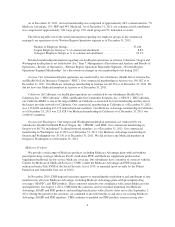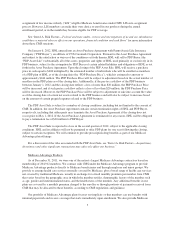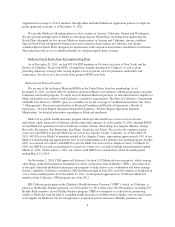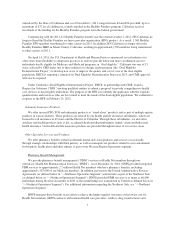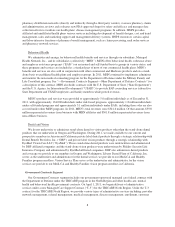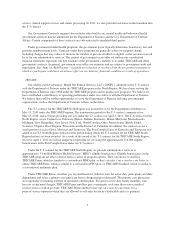Health Net 2011 Annual Report Download - page 16
Download and view the complete annual report
Please find page 16 of the 2011 Health Net annual report below. You can navigate through the pages in the report by either clicking on the pages listed below, or by using the keyword search tool below to find specific information within the annual report.Additional Information Concerning Our Business
Competition
We operate in a highly competitive environment in an industry currently subject to significant changes from
business consolidations, new strategic alliances, market pressures, and regulatory and legislative reform
including but not limited to the federal health care reform legislation described below in “—Government
Regulation”. Our health plans face substantial competition from both for-profit and nonprofit health plans that
offer HMO, PPO, self-funded and traditional indemnity insurance products (including self-insured employers and
union trust funds). We also face substantial competition from both for-profit and nonprofit health plans, as well
as other non-health plan companies with respect to our contracts with the federal government, including our
T-3 TRICARE and MFLC contracts, which are subject to periodic re-competition. Some of our competitors have
substantially larger enrollments and greater financial resources than we do. We believe that the principal
competitive features affecting our ability to retain and increase membership include the range and prices of
benefit plans offered, size and quality of provider network, quality of service, responsiveness to customer
demands, financial stability, comprehensiveness of coverage, diversity of product offerings, market presence and
reputation. The relative importance of each of these factors and the identity of our key competitors varies by
market and product. We believe that we compete effectively against other health care industry participants.
Our primary competitors in California are Kaiser Permanente, Anthem Blue Cross of California, Blue
Shield of California and UnitedHealth Group, Inc. Together, these four plans and Health Net account for a
majority of the insured market in California. Based on the number of enrollees, Kaiser is the largest managed
health care company in California and Anthem Blue Cross of California is the largest PPO provider in California.
There are also a number of small, regional health plans that compete with Health Net in California, mainly in the
small business group market segment. In addition, two of the major national managed care companies, Aetna,
Inc. and CIGNA Corp., are active in California. While CIGNA’s commercial full-risk market share is not as
significant as that of our primary competitors in California, we believe that it remains in California primarily to
serve its national, self-funded accounts with employees in California. CIGNA is one of our primary competitors
in the large group market and Aetna is a competitor in both the small and large group markets.
In Arizona, our largest competitor is Blue Cross Blue Shield of Arizona. We also compete with
UnitedHealth Group, Inc., Aetna, Inc. and Humana Inc. Our Oregon health plan competes primarily with
Providence, Regence Blue Cross/Blue Shield, Kaiser, PacificSource, ODS Health Plans, Inc., Lifewise and
UnitedHealth Group, Inc.
With respect to our T-3 TRICARE and MFLC contracts, our primary competitors include Humana, United
HealthGroup, Inc., Aetna, Inc., Magellan Health Services, ValueOptions, Inc. and TriWest Healthcare Alliance,
among others.
For additional information on competitive conditions in our business, see “Item 1A. Risk Factors. “The
markets in which we do business are highly competitive. If we do not design and price our product offerings
competitively, our membership and profitability could decline.”
Marketing and Sales
We market our products and services to individuals and employer groups through internal sales staff,
independent brokers, agents and consultants and through the Internet. For our group health business, we market
our products and services utilizing a three-step process. We first market to potential employer groups, group
insurance brokers and consultants. We then provide information directly to employees once the employer has
selected our health coverage. Finally, we engage members and employers in marketing for member and group
retention. For our small group business, members are enrolled in the plan chosen by the employer. In general,
once selected by a large employer group, we solicit enrollees from the employee base directly. During “open
enrollment” periods when employees are permitted to change health care programs, we use a variety of
14


